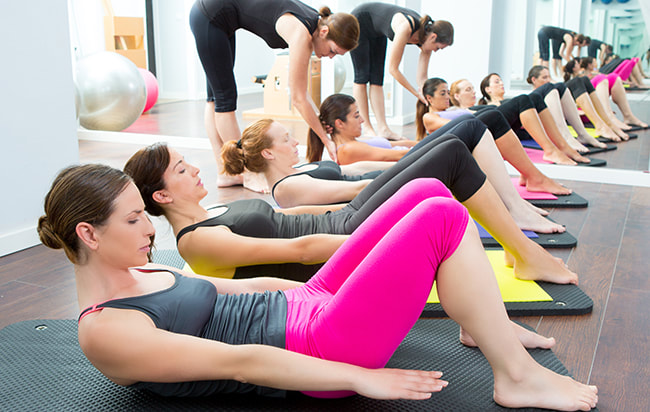|
These exercises can be done as way to accelerate recovery at home. Ask your physiotherapist how many sets and times per day you should be doing each exercise based on your needs.
1. Pendulum stretch Relax your shoulders. Stand beside a surface and lean over slightly with the affected arm hanging down. Swing the arm in a small circle — about 30cm in diameter. As your symptoms improve, increase the diameter of your swing and use a small weight. 2. Towel stretch Hold one end of a three-foot-long towel behind your back and grab the opposite end with your other hand, holding in a horizontal position. Use your good arm to pull the affected arm upward to stretch it. Hold the bottom of the towel with the affected arm and pull it toward the lower back with the unaffected arm. 3. Finger walk Face a wall three-quarters of an arm’s length away. Reach out and touch the wall with the fingertips of the affected arm. With your elbow slightly bent, slowly walk your fingers up the wall until you’ve raised your arm as far as you comfortably can. Your fingers should be doing the work, not your shoulder muscles. Slowly lower the arm and repeat. 4. Cross-body reach Use your good arm to lift your affected arm at the elbow, and bring it up and across your body, gently stretching the shoulder. You may do this either sitting or standing. 5. Armpit stretch Using your good arm, lift the affected arm onto a shelf at chest level. Gently bend your knees, opening up the armpit. Deepen your knee bend slightly, gently stretching the armpit, and then straighten. With each knee bend, stretch a little further without force or pain. 6. Outward rotation Hold a rubber exercise band between your hands with your elbows at a 90-degree angle close to your sides. Rotate the lower part of the affected arm outward 5cm and hold for 5 seconds.
4 Comments
Walking is one of the easiest exercises to incorporate into your daily routine to maintain physical health and improve mobility. Although we do it every day to get from one place to another, walking for an extended period of time should be approached like any exercise. The Canadian Physiotherapy Association (CPA) created the acronym S.M.A.R.T. (stretch, move, add it up, reduce strain, talk to a physiotherapist) to help you start.
Stretch Warming-up your muscles helps you move easily and reduces the risk for injuries or strains. Stretching should be done before, during and after walking and should include the calves, hamstrings, quads, and hips. Stretching should never be painful. Do not stretch further after you feel a gentle pull of the muscle. Move Walking is not just about putting one foot in front of the other. Control your breathing by consciously inhaling deep through the nose and exhaling through the mouth. You can add more to your workout by using vigorous movement of the arms, with or without bent elbows. Add it up Keep track of the amount of walking that you do each day. Setting aside an hour for a good walk is equally as beneficial as doing 20 minute walks 3 times a day. Keep walking, but for shorter distances or at slower speeds, when the weather gets worse so that you can continue your routine for all 12 months of the year. Reduce Strain There are many factors involved in the potential risk for strain, including the gear you use. Wear proper walking shoes that fit your need and type of walking program. Shop around for pouches, backpacks, etc. that help ease the amount of weight you carry. The CPA also recommends that you do not use wrist or ankle weights while walking which add too much stress on your joints. Talk to a Physiotherapist Physiotherapists not only treat an existing injury; they also teach you how to prevent the onset of pain or injury that prevents you from completely your daily routines with ease. See a physiotherapist if you want to begin an exercise routine with the goals of increasing your mobility, relieving pain, building strength, and/or improving balance and cardiovascular health. Many spices have been shown to offer health benefits and reduce your risk of chronic conditions such as cancer, diabetes, and heart disease. However, recent studies have found that certain spices are linked to healing physical conditions. Here are four spices that are proven to reduce pain symptoms.
1. Turmeric Best for: Stomach pain and IBS Why it works: Turmeric's main component, curcumin, is a powerful anti-inflammatory. One study showed that curcumin was shown to be as effective a pain reliever as ibuprofen, but with less stress to the stomach, and another revealed that it lowered symptoms of IBS by 50% by reducing inflammation and intense muscle contractions in the bowel. How to take it: Add just half a teaspoon of turmeric to your dinner or take 400-600mg capsules with each meal. 2. Black Pepper Best for: Arthritis, stomach pain, and digestive problems Why it works: A common remedy used in traditional Chinese medicine, pepper contains compounds that have anti-inflammatory properties. A recent study found that one of the chemicals in pepper inhibited the human cells' inflammatory activity, meaning that pepper would be an effective treatment for people with arthritis. How to take it: Incorporate freshly ground peppercorns in your meals, or try it as a supplement in 10mg capsules. 3. Ginger Best for: Headaches Why it works: In a recent study, 100 people with migraines were given either 50mg of the migraine drug, sumatriptan, or 250mg of powdered ginger. 64% of people given ginger and 70% of those given sumatriptan reported a 90% reduction in pain. However, 20% of the group that used the migraine drug experienced side effects that included dizziness, vertigo, and heartburn. How to take it: Use fresh or powdered ginger in cooking, try eating pickled Japanese sushi-style ginger, or drink ginger tea. 4. Peppermint Oil Best for: Upset stomach and IBS Why it works: According to a 2014 Journal of Gastroenterology, enteric-coated peppermint oil is considered one of the primary choices for treatment of IBS cramps and pain. How to take it: Drink peppermint tea, or take capsules containing 0.2 ml of peppermint oil. Most people are unaware of the bad habits they have developed that affect both posture and increased weight bearing on your muscles. The solution to your pain can be as simple as adjusting the ways in which you position your body throughout the day so your muscles can stay in a more neutral state.
1. Crossing legs when sitting This unnatural elevation of the hip compresses the opposite side, which is carrying more of your body weight. Your spine can also be pulled out of alignment and create pressure on your sciatic nerve, causing both back and hip pain. If it isn't comfortable having your feet flat on the floor, try overlapping your ankles instead of your legs. 2. Hunching shoulders and craning neck while sitting at your desk Most people with desk jobs subconsciously adopt bad posture while sitting in front of the computer. The problem is that leaning forward and allowing your shoulders to collapse compresses your chest muscles and strains your shoulders and upper back. Two simple tricks can instantly improve your posture: use a supportive chair pillow for your lower back and keep your screen at eye level to prevent you from tilting your head up or down to see. 3. Sleeping on stomach versus side Sleeping on your stomach can cause a lot of strain on your back and neck as the pillow adds an unnatural lift. However, sleeping on your side also causes your head be turned to either the right or left for an extended period of time, which also causes pain. Therefore, the best position for sleeping is lying on your back, with only one pillow beneath your head. Consider placing a pillow between your knees to help support your spine and stabilize the middle of your body while sleeping on your side. If you must sleep on your stomach, limit yourself to only one pillow. 4. Carrying a heavy bag or purse Carrying a large amount of weight on your shoulders can form uneven muscle tone and disrupt the blood flow, which can eventually cause discomfort in your neck, shoulders, and back. Switch to a rolling briefcase or cross-body bag, which both evenly distribute weight, if you have to carry a lot. 5. Wearing high heels Wearing high heels (two inches or higher) often can cause your calf muscles to shorten by 13 percent over the course of just two years. This is mainly due to the increased compression of your calf muscles and tendons, as well as inflammation of the Achilles tendon. Switch to flat or low-healed shoes with rounded or square toe boxes to prevent the wearing down of your calf muscles. Keep your calf muscles strong with regular stretches and exercises. Whether you're starting a new exercise regime or have always been physically active, being aware of the most common mistakes people make is important to prevent injuries and further aggravation of muscle or joint pain.
We've highlighted 5 of the most common exercise related mistakes: 1. Not Stretching Stretching before a workout is important to prevent pulling or straining your muscles. Stretching make your muscles flexible and begins the circulation of oxygen throughout your body. A pulled muscle is not only painful, but will stop you from continuing your routine for several days. 2. Overestimating Strength and Endurance Many people who begin a new exercise program make the mistake of overestimating their strength and endurance. Starting with weights that are too heavy or doing too many reps can wear your muscles down and bring on pain. Building yourself up to using heavier weights, longer reps, and lengthier cardio should be done gradually overtime to prevent injuries. 3. Doing Too Much Plan ahead and rotate which muscles you want to target each day rather than spending only a few minutes on multiple muscle groups. Spend enough time working out your target area to fully engage the muscles so you are able to properly build strength and endurance. 4. Overcompensating Life can get busy, and many people are easily derailed from their regular exercise routine. Attempting to make up for a lack of exercise with more activity than you're used to can be a strain on your body. The longer you go between exercise sessions, the more you'll have to work at building up strength and endurance again. 5. Choosing the Wrong Workout Every person has their own unique needs and goals when it comes to exercise and you should choose your impact level and routine accordingly. Whether you are recovering from an injury, muscle, or joint pain, or are trying to adopt a healthier lifestyle, seeking expert advice from a physiotherapist or personal trainer will be beneficial so you can have an individualized workout routine. |

 RSS Feed
RSS Feed




